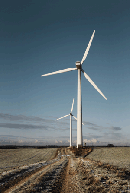An estimated 1 billion people worldwide lack access to affordable clean drinking water and community desalination plants are cropping up in developing nations to address these shortages. The downside is they rely heavily on fossil fuels.
Wind4Water, a social enterprise based in Plymouth, Mass., proposes a cleaner, more sustainable approach in the form of pre-engineered, wind-powered desalinization facilities.
There are four configurations: the smallest produces about 379,000 gallons of fresh water daily, the largest generates more than 1.5 million gallons per day.
Each plant combines 750-kilowatt wind turbines supplied by Aeronautica Windpower of Plymouth with reverse osmosis desalination technology manufactured by Water Management Group of Coral Gables, Fla. Associated Wind Developers, also based in Plymouth, provides the engineering, construction management and long-term maintenance services for each project.
Depending on the amount of water required, the systems use 1, 2, or 3 wind turbines to produce electricity and trigger the desalinization process. The systems are managed with special software that prioritizes the amount of water processed depending on the wind conditions.

"When the wind is blowing strongly, proprietary controls automatically create extra fresh water, which is stored in over-sized tanks," explains Wind4Water on its Web site. "When the wind is blowing at lower speeds, electricity is used just to pump water around the system, or for delivery. The system is sized so that the wind can stop completely for up to a day while water is drawn from fresh water tanks before additional electricity is drawn from either the grid or an on-site generator."
The first Wind4Water project is slated for Cape Verde, a small island off the west coast of Africa that has little groundwater.
"We are excited about what this means for communities that have historically gone without affordable fresh water," project co-founder Bob Kuhn told WindPower Engineering. "With low-cost access to safe sources, communities can avoid many of the diseases associated with inadequate supply, liberate women and children from fetching water, and achieve a new level of economic and natural resource sustainability."
The plants can be located near oceans, inland seas, lakes, rivers and existing wells. They are best suited for areas with moderate wind resources greater than 11.2 miles per hour (mph) on average a year. "This results in lower water prices immediately, and well into the future," says Wind4Water. "As fossil fuels continue to escalate in price, wind power will remain a lower priced solution because the main ‘cost’ of the equipment, its cost of financing, was ‘locked in’ when the project started."
Project costs are estimated between $4 million and $12 million, installed, depending on the size of the system, says Wind4Water. The organization will fund projects through a combination of private donations (which usually have a tax benefit) and public debt sources such as the World Bank or African Development Bank.
Project economics for investors depend on factors such as wind speed, water costs and energy fees in each location, and the company is prioritizing projects that offer annual rates of return in excess of 20% of investments.
Here’s the website:
